Time flies when you’re having fun, which is why some workouts feel so long. Where did all the fun go? When something is fun, we usually want to do it more often. Play is inherently pleasurable. Plyometric exercises are inherently intense. Combine the two for an intense, yet enjoyable workout experience.
What is Play?
Imagine the scene at a playground: Kids are scattered around engaging in an array of physical activities at nearly full speed and completely absorbed in the experience. If you think about any time you have been lost in play or have observed children or others lost in play, you will easily recognize the following characteristics of play, as outlined by Stuart Brown in his book, Play:
- Apparently purposeless (done for its own sake)
- Voluntary
- Inherent attraction (you’re drawn to it)
- Freedom from time
- Diminished consciousness of self
- Improvisational potential
- Continuation desire (you want to keep doing it)
What are Plyometrics?
Plyometrics are not jumping. Plyometrics are any exercise that features a rapid loading of muscle followed by a rapid unloading of muscle. Think of dropping down quickly to jump—the drop is the “load” and the jump is the “unload.” The key is that the speed turns on the stretch reflex. If you drop down quickly, it’s easier to get back up than if you lower down slowly. The stretch reflex makes your muscles behave like giant rubber bands and creates an elastic rebound effect.
Now it’s time to put play and plyometrics together.
How to “Plyo Play”
You need more than just a plyo exercise to make exercise playful. For playfulness, include elements of reactivity, coordination and interactivity into your workouts.
- Reactivity – taking in information from the outside world through your senses and producing a physical response (e.g., I throw you a ball and you catch it)
- Coordination – combining a series of movements or body actions to produce a smooth, larger movement (e.g., walking and bouncing a ball)
- Interactivity – engaging with one or more other people verbally, visually or competitively
Take a plyometric exercise or movement, add reactivity, coordination or interactivity and you have the formula for “Plyo Play!”
Single-arm Teamwork Slam
Playful elements: reactivity, coordination, interactivity
How to Do It: Partner A and B face each other. Partner A leads by performing a single-arm medicine ball slam; on the rebound, partner B performs a slam with the same side arm as partner A. On the next rebound, partner A switches hands, as does B on the next slam.
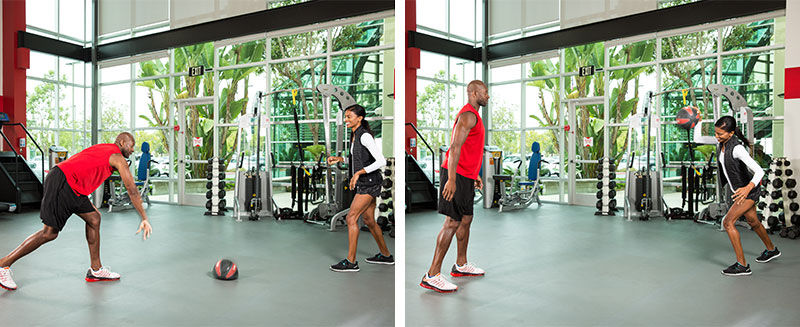
360-degree Swing With Reactive Side Slam
Playful elements: reactivity, coordination, interactivity
How to Do It: Partner A holds the ball with both hands and performs a continuous 360-degree swing in a circle. Upon hearing the chosen word from partner B (“pizza” in the sample video), partner A slams the ball, immediately catches it, and resumes the 360-degree swing in the opposite direction.
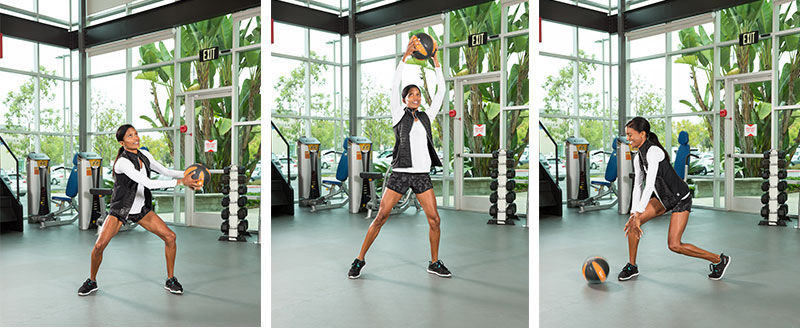
Side Hurdle Jump
Playful elements: reactivity, coordination, interactivity
How to Do It: Partner A holds one side of the Qube with each hand and begins by hurdle jumping sideways over the Qube. Alternate sides continuously until the “stop” command is given by partner B. Partner A resumes the exercise when partner B gives the “go” command.
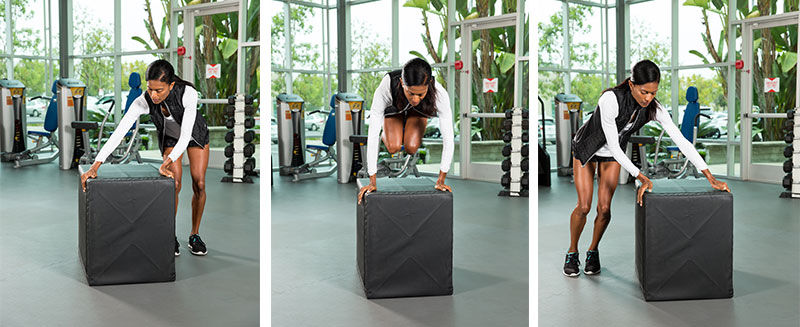
Reactive Flip (tactile or verbal)
Playful elements: reactivity, coordination, interactivity
How to Do It: Partner A touches a side of the Qube; partner B flips or turns the Qube to finish with that side face up. If partner A touches the side that is already up, partner B must do a 180-degree flip so that the bottom becomes the top. Note: This same exercise can also be done with verbal commands by calling out 20, 24 or 30, corresponding to the available heights of the Qube.
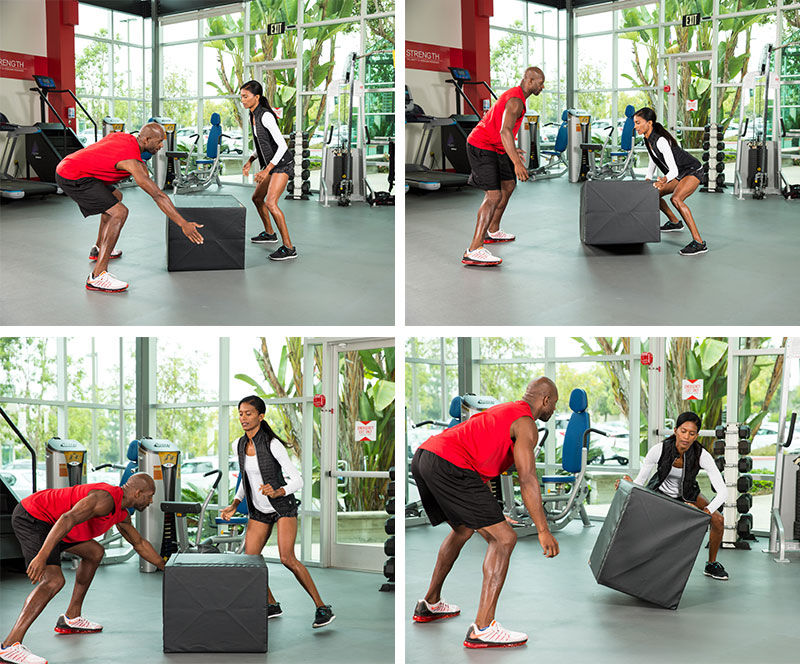
Quick Up
Playful elements: reactivity, coordination, interactivity
How to Do It: Partner A starts in a hand plank on the platform. Performing a hip drop to load the body, partner A rapidly tucks the legs and lands on the platform. Partner B tosses a ball or other object, which partner A must catch upon landing. Partner A can either step back to the starting position or jump back for more challenge (shown first in the video).
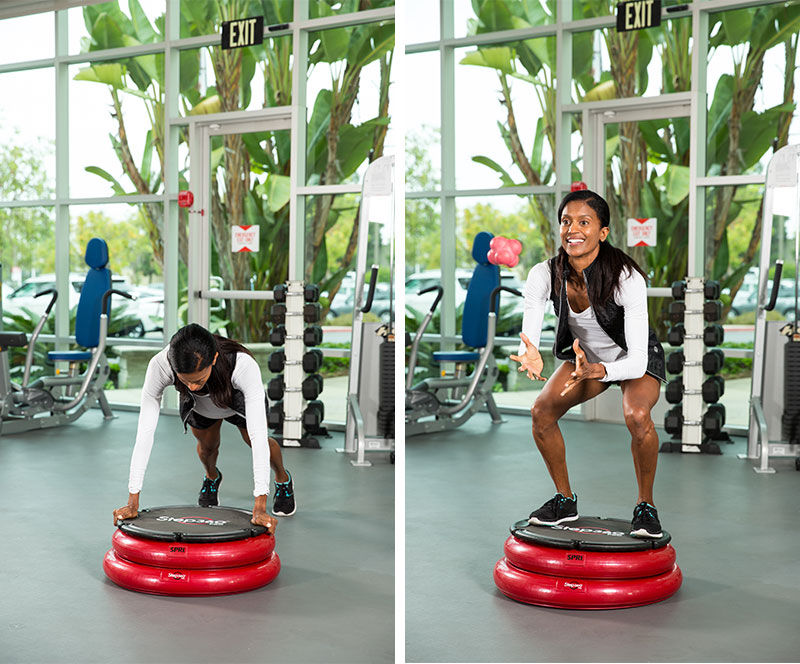
Crouching Lateral Plank
Playful elements: reactivity, coordination
How to Do It: Partner A starts in a crouch position with the 360 Trainer upside down and holding the bottom bladder. Partner A begins moving around the 360 Trainer in one direction and changes direction every time partner B calls “switch.”
Putting Plyo Play Into Practice
Use a minimum of two sets consecutively, as this will allow for learning between the first and the second set, which will enhance the quality of performance and enjoyment. (For exercises that require taking turns with a partner, each partner will perform two sets, for a total of four sets.) Use a circuit-style format, with time intervals of 25-35 seconds and rest intervals between 15-30 seconds per set.
Wrap Up
Before any physical changes can take place, a change in attitude is required to drive consistent participation in exercise. A single workout results in little physical change, but it can lead to a different emotional experience. Improve how people feel about exercise and you have improved their chances of sticking with their workouts. Change the experience of exercise and you can transform your emotional response to exercise—in a single session.
Deliver the individualized programs people need to adopt long-term, healthy behaviors with ACE’s Personal Trainer Certification.
 by
by 









 by
by